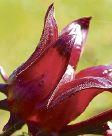
BORN IN Kingston and raised in Port Antonio, Cheryl Green possesses both the fast-paced energy of the city and the down-to-earth vibe of the country.
After completing her Bachelor of Science degree in biology at Marymount College in Tarrytown, New York, she had stints in various research and development posts in the United States before returning to Jamaica. Ms. Green has since started an M.Sc. in tropical ecosystems assessment and management in the Department of Life Sciences at the University of the West Indies.
While she studies at the UWI, she also holds a post at the Scientific Research Council as a research scientist, where she has researched and developed cosmoceuticals such as lotions, soaps, body wash, an age-defying eye cream and a shampoo from the Jamaican sorrel.
Ms. Green hopes that the products will assist in the further development of the local functional food industry.
JAMAICAN SORREL FACT SHEET
Scientific Name: Hibiscus Sabdariffa L.
Family: Malvacene
Common names: Traditional Red, Bashment, Manchester Black
Plant origin: Originally from Angola, but nowadays Sorrel is cultivated worldwide throughout the tropics. Imports come especially from Sudan and Egypt, as well as Thailand, Mexico and China.
Taste: Sourish
Ecology:
The Bashment is an annual herbaceous plant.
The Traditional Red and the Manchester Black are perennial plants.
It grows to six feet in height.
Chief 'sorrel parishes': Clarendon, Manchester, Portland, St. Andrew.
Parts of the plant used: Calyx, seeds and leaves.
Medicinal uses:
Calyx: Contains flavonoids and proanthocyanidins which are associated with antioxidant activities.
Seed: The oil from the seed contains anti-inflammatory properties.

